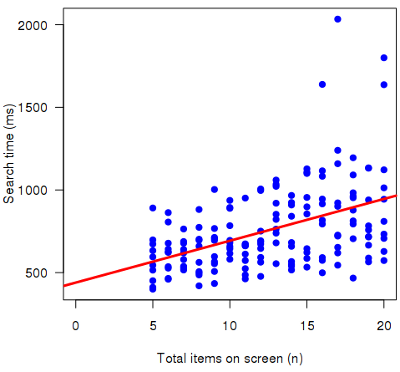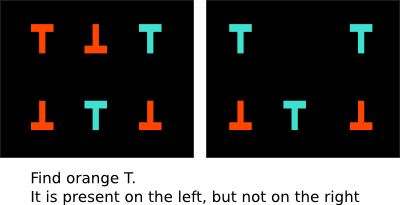Introduction
In a visual search experiment, a target is the item that you need to find. A distracter or distractor is an item that you are not looking for, and which distracts you from finding the target.
By the way, distracter and distractor are just different ways of spelling, both correct.
-
Searching for keys on a messy table
-
Searching for your wallet
-
Searching for teabags in the supermarket
-
Searching for your name on a list of names
Psychologists have studied how we search, and what can make search easy and what can make search hard. For example, try the find a red circle in the picture on the left and in the picture on the right. In both cases, there is just one red circle, but it is much easier on the left. The red circle "stands out", this is known as the pop out phenomenon.

In the example on the right, the time it takes on to find the object depends on how many non targets (distractors) there are. The more there are, the longer the search time. In the figure below, you see the data of 160 trials. There were between 5 and 20 items on screen. The more items, the longer the search time. The red line is the search slope.

In many visual search experiments, stimuli are multidimensional. For example, in the demo, you need to find a stimulus that varies on two dimensions, color (orange or blue) and shape (normal or upside down T). All you need to do is to decide whether there is a normal orange T (not an upside down one!) and if so, you press a button. The computer measures the time it takes you to press the button. In a visual search experiment, this time can be called the search time.
Searching for a specific combination of two stimulus features (such as an upside and orange T) is called conjunctive search. In a conjunctive search, you look for the combination, that is the conjunction of two features. Conjunctive search is more time consuming than search for one feature. Below is are two examples of conjunctive search. It is still relative easy to find the orange T, but that is only because there are so few distracters.

In the figure below, you see two example trials. The search target is only present in the panel on the left. Also, note that on the left there are 6 items on screen, and on the right only 5. The fewer items on screen, the easier it is to make your decision.

Do it yourself
In the demo, you need to find an orange T. The number of distractors varies. The distractors can be an upside down orange T and a blue T. If you save the data (you need to download all files to do so), you can calculate your own search slope.
Why is it important?
Psychologists study fundamental psychological processes, and one of them is searching. Searching is not just important in modern life. Our ancestors were dependent on finding food. Hunters search for moving animals and gatherers search for vegetables, fruits, nuts, mushrooms. You can imagine how difficult it can be to find these items amongst all the non-edible items which might look similar. Indeed, efficient searching and gathering has evolutionary advantages.
Ideas for homework
-
Do you think that men and women are equally good at searching? How does this relate to evolutionary theories? What do we know about sex differences in visual search?
-
All the stimuli in the demonstration use multidimensional stimuli. Design an experiment in which you compare stimuli that vary on just one dimension, such as colored circles, with stimuli that vary on two dimensions (color and shape).
-
What does the steepness of the search slope tell us about how we search?
Reading material
-
Treisman, A. (1977). Focussed attention in the perception and retrieval of multidimensional stimuli. Perception and Psychophysics, 9, 40-50.
-
Stoet, G. (2011). Sex differences in search and gathering skills.Evolution and Human Behavior, 32, 416-422.
